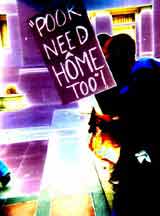|
by Terry Messman
Suppose a surreal scene (for, in Oakland, politics is the
art of the surreal). Suppose an elitist city planner goes
out of control after watching the film, Invasion of the
Body Snatchers, where the real inhabitants of a town are
replaced, one by one, with aliens and no one is supposed
to even mention the sinister plan. In a frenzy, said city
planner decides to create a master plan for the secret
removal of the unwanted poor from Oakland and their
one-on-one replacement by white, affluent dot-commers.
Quick shift of scene to the Oakland mayor’s office,
where the blueprints for the removal of the poor have
already been drawn up by the landlords and city planning
officials working in tandem to slowly replace the
longtime residents of downtown Oakland, one by one,
with outsiders…
A city report leaked to Street Spirit by Lynda Carson, an
anti-eviction activist who works with Just Cause
Oakland, shows that Mayor Jerry Brown ordered his
housing development staff to conduct a survey of all 24
Single Room Occupancy (SRO) hotels in the Central
District and analyze how much it would cost to remove
and replace them, presumably with market-rate housing
and upscale commercial developments.
Outrage among advocates
Housing advocates in Oakland are expressing outrage
that Brown would even request a secret report to analyze
what it would cost to eliminate low-income hotels in the
downtown area. The analysis, conducted for Brown by
city staff in the Housing Development Section, surfaced
recently in activist circles, although it had circulated
among a small inner circle at City Hall considerably
before then.
Even though the price tag for eliminating all 24 SRO
hotels in Oakland’s Central District may be prohibitively
expensive and therefore unworkable, tenant advocates
called it a betrayal by Jerry Brown of his poorest
constituents and a blueprint for increased homelessness.
"I found it to be chilling," Carson said. "When I first got
wind of that survey, I tried to visualize all these people
being forced to move out of their homes and relocate. It
really sunk in on me that if all the SROs are gone, there
will really be no place in Oakland for those of us who
have hit rock bottom."
Staff members of several Oakland housing agencies
confirmed that the report was prepared because Jerry
Brown and the redevelopment officials in charge of
pushing his plan to bring 10,000 new residents into the
downtown believe it will be very hard to "market"
Oakland when so many poor people are on the streets.
Advocates close to the mayor’s office say that Brown
had told his staff that SROs are the culprit and should be
closed down because there are too many low-rent hotels
and, therefore, too many poor people.
"Jerry Brown is under the influence of wealthy
developers who may fear that it’s very difficult to bring a
lot of rich new residents into a downtown area dominated
by poor people," said Carson. "I think the mayor’s office
is full aware that it’s discouraging to his plans to bring in
10,000 rich people to see so much poverty in their face
night after night."
Blueprints for gentrification are nearly always designs
for dislocation, eviction and homelessness. The moral
blindness of this mayoral administration is that it would
remove real, flesh-and-blood citizens of Oakland who
have lived downtown all their lives for fantasized hordes
of upscale people who have never yet lived in Oakland.
"It’s a pipe dream of Jerry Brown," said Carson. "His
slogan is ‘Oaklanders First.’ But Oaklanders first are
being run out of town."
The stages of gentrification
The first stage of this blueprint for gentrification and
homelessness requires a mayor willing to turn a blind eye
as Oakland’s avaricious landlords jack up the rents to
unconscionable levels and unleash a barrage of no-cause
evictions on poor renters and people of color.
The second stage of this plan involves canceling the
City’s lease with the Henry Robinson Multi-Service
Center, the largest transitional housing program for
homeless families in the East Bay, and negligently
allowing many other homeless services to be driven out
of downtown Oakland by escalating rents. But the
Multi-Service Center is only one of an estimated 24 SRO
hotels that provide the only housing still affordable to the
poorest residents of downtown Oakland.
Therefore, the third stage of this design for displacement
is clear: Target the other SRO hotels for possible
removal. Evidently, that is just what Jerry Brown began
contemplating last summer.
The report prepared for Brown by the City’s Housing
Development staff estimated that it would cost more than
$102 million "if the SROs were to be acquired by private
developers" and more than $162 million "if the
Redevelopment agency were to acquire these hotels given
the additional, state-required relocation costs of
$25,000/unit."
The study begins on an ominous note: "In order to assist
our discussion of this topic with Mayor Brown, the
Housing Development Section has analyzed the estimated
value of all the Single Room Occupancy Hotels (SROs)
in the Central District. In addition, we have reviewed the
report prepared by the Police Department regarding crime
reports and arrests near the SROs and have reviewed the
Code Enforcement Division’s records with respect to
building conditions."
Those are chilling words to anyone who knows the
history of how city officials in Oakland’s code
enforcement division have worked hand-in-glove with
the police and fire departments to close down unwanted
SROs, such as the El Centro and the Royal, in the past.
Police crime reports, coupled with complaints received
by the code enforcement division, can be used to close
down these buildings. Once an SRO has been
red-tagged, its market value plummets, and it becomes
more feasible for a private developer to buy it out and
remove or renovate it.
A brake on Brown’s ambitions?
Reportedly, this study was completed under the direction
of Oakland Housing Director Roy Schweyer, a longtime
supporter of affordable housing, and that may have
resulted in some cautionary observations that placed at
least a momentary brake on Mayor Brown’s ambitions.
The report warns, for instance, of dire consequences if
SRO units are eliminated entirely: "The elimination of
these units, which provide shelter, and in some cases,
social service resources would create an increase in
homelessness. The impact then could be a larger
presence of displaced people on the streets of
downtown."
Yet despite this warning, the report recommends
developing a comprehensive strategy that would include
"continued and stepped-up code enforcement activities,"
and even more chillingly, "marketing the areas and the
privately owned SROs to private developers."
That marketing strategy may be Brown’s best hope to
begin removing SRO hotels in a piecemeal fashion,
rather than in one fell swoop. When the city staff put the
numbers together (reportedly, sometime last August), it
became apparent that finding $100-$160 million to
remove all 24 SROs at once was nearly impossible.
Affordable housing advocates say that Brown’s real
game now is to implement this plan incrementally by
encouraging private developers to buy out SROs one by
one and replace them with new commercial offices or
market-rate housing.
Also, sources close to Mayor Brown say he was set back
on his heels by the community outcry against his plan to
bring in 10,000 new market-rate housing units while
rejecting any low-income housing in a time of rising
rents and eviction rates. Because of this widespread
criticism of the potential loss of affordable housing,
homeless advocates say that Brown has backed off
somewhat and now is supposedly more open-minded
about including a modicum of affordable housing in his
master plan to perform cosmetic surgery on downtown
Oakland.
But boona cheema, a longtime homeless advocate and
social services provider, warns that even when the mayor
talks about supporting bonds for affordable housing, he
is talking about housing for people at 80 percent of the
median income – housing that will never help homeless
people remain in Oakland.
A Trojan Horse
All too often, that is simply gentrification by another
name – using the promise of affordable housing as a
Trojan Horse to smuggle in higher-rent units for
middle-income renters in a city with a crying need for
housing for very low-income people.
Cheema, the executive director of Building Opportunities
for Self-Sufficiency (BOSS), has seen and studied the
secret city report on SRO hotels. She commented, "I
think Jerry Brown is really misguided. We have poor
people and disabled people and mentally ill people who
he wants to address from a law-and-order point of view,
and not a public-health point of view."
BOSS provides a comprehensive array of services,
shelter, long-term housing, counseling, job training and
referrals to homeless people in Alameda County.
Because of rising rents, cheema said, the poor people her
agency serves are facing a far greater struggle to remain
housed and avoid eviction than ever before – so Brown’s
proposed tampering with some of the last truly affordable
housing in Oakland comes at the worst possible time.
"We need more services for poor people," cheema said.
"We need to create a downtown in Oakland that is truly
mixed. Poor people have lived there for years. The SROs
are their only home. So in a way, Jerry Brown is
ass-backwards in his approach. By removing the SROs,
he will create more poor people on the street, like in San
Francisco."
Brown’s highly touted plan to upgrade Oakland’s
downtown has always consisted of an overt agenda and a
covert agenda. The publicly announced agenda is to
work with large real estate developers and contractors to
build market-rate housing for 10,000 new residents –
middle-income and affluent people who would create a
"more desirable" populace when the mayor tries to entice
big business to move into downtown Oakland.
But the hidden part of this so-called "10K" plan is to
drive away all the social problems and poor people that
might make downtown Oakland an unappealing place to
live for your average, upwardly mobile dot-commer.
The people advising Brown on his 10K plan to redevelop
and upgrade downtown Oakland, said cheema, have
made a fundamental error in judgment. "They’re up to no
good, because their thinking is flawed," she said.
"Instead of putting in resources to help people, they go at
the problem in a way that will create more problems.
Who is thinking for this man? He’s not thinking with
long-term vision. He’s just thinking, ‘We’re really
wired. Let’s bring in the techies.’"
An urban removal project
Brown has definitely chosen a new approach to the
age-old problem of poverty – not an urban renewal
project, but a flat-out attempt at urban removal.
Housing developers and homeless advocates labored
intensively for years to create an umbrella of support
services for poor people in downtown Oakland.
Programs for poor people blossomed, including the
Henry Robinson Multi-Service Center, the First Step
recovery program, St. Mary’s Center for Homeless
Seniors, Sentinel Fair Housing, the Oakland
Independence Support Center, BOSS, Traveler’s Aid,
Dignity Housing West, and Oakland Community
Housing, Inc.
Now, ironically, some of the very service centers set up
to help the poor and homeless are themselves threatened
by rapidly rising rents and face the same bitter fate of
displacement and eviction undergone by those they set
out to help.
Clearly, the SRO hotels are first on the endangered list.
SROs are rarely popular in the halls of power. The fatally
prejudicial notion in the elite circles of real estate
developers, mayors, and city planners is that SROs
contribute to urban blight and provide cover for the
undesirable poor, the mentally disabled, substance
abusers and street people. Thus, they are viewed as an
impediment to Oakland’s long-thwarted progress
towards becoming an affluent city of gleaming
skyscrapers and thriving commerce.
In truth, much of this "housing of last resort" is far from
ideal. SRO hotels run the entire spectrum – the good, the
bad and the ugly. Nonprofit agencies have created
architecturally attractive SROs that are models of decent,
humane housing, while slum landlords have let SRO
hotels deteriorate into rat-infested firetraps.
Hovel or haven
But, hovel or haven, one thing is certain about SROs:
they’re an absolutely essential lifeline for the poorest
citizens. They are indispensable in providing one of the
last places of refuge where very low-income people can
live without being forced to sleep on a chunk of
discarded cardboard in an alley.
The growing tragedy of homelessness in modern
America is inescapably bound up with the loss of SROs
to demolition, gentrification, fires, and conversion to
tourist hotels. In city after city across America, the
equation couldn’t be more precise or chilling – the loss or
destruction of every SRO hotel has always resulted in
ever-greater homelessness.
When I worked with the Oakland Union of the Homeless
from 1986-1994, we organized rent strikes and worked
with attorneys to have successful lawsuits filed against
some of the more slum-ridden SRO hotels. But make no
mistake: SRO housing was essential then to the
preservation of the lives of the poor in downtown
Oakland. It still is.
To have a mayor come into Oakland from the outside –
without understanding its problems or its history,
without caring about the effect his grandiose plans will
have on its poorest residents – is an outrageous misuse
of political power. Every major study of urban
homelessness has concluded that the loss or destruction
of SRO hotels is an absolutely central cause of increasing
homelessness.
The U.S. Conference of Mayors has released carefully
documented reports every year tracing the rise in
homelessness in the major U.S. cities for the past 15
years. A major component of this increase in
homelessness documented by their reports is the loss of
SRO hotels caused by gentrification.
So why is Oakland’s mayor so clueless about this
phenomenon? He isn’t. He knows full well that bringing
in his sleek crowd of yuppies and dot-commers will
cause displacement of the poor. He asked for this study
of SRO hotels precisely to see how fast and how far he
could go to expedite that displacement.
Watch this administration carefully as it goes about
polishing its image by encouraging big real estate
developers to buy off entire city blocks. Watch every
time a developer takes over a parcel of land in downtown
Oakland that has a homeless program or a low-income
hotel where poor people live. Where that happens, start
an SRO death-watch. Maybe drop off a memorial wreath
or decorate the block with black armbands to lament the
lost housing of the urban poor. Better yet, sit-in at the
mayoral offices of the Evictor-in-Chief responsible for
these designs for displacement.
Preferential option for the rich
A deliberate choice is at work when Jerry Brown uses
the full power of his office to attract the rich while he
presides over the displacement of Oakland’s homeless
programs and SRO hotels, and turns a blind eye to the
growing evictions of poor people and people of color.
What should we name this fateful choice that the Brown
administration seems hell-bent on making?
Jerry Brown, the former Jesuit seminarian, knows that
all over the world, Catholic bishops and nuns and priests
have made "the preferential option for the poor" a central
commitment of their lives and faith. In Latin America
alone, hundreds of priests, bishops and nuns have given
their very lives to stand in solidarity with the aspirations
of the poorest of the poor. And not just the clergy, but
thousands of lay people in countless churches have
dedicated their lives to this preferential option for the
poor.
What then constitutes the core of Jerry Brown’s urban
removal policy? A preferential option for the rich. And
given that most of the people evicted in Oakland have
been and will be people of color, it is inescapably a
preferential option for the affluent white.
"For someone who puts himself across as having lived
with Mother Teresa and being a Jesuit seminarian –
excuse me, I know something about that spiritual path,
and this man is not on it," said boona cheema. "If you
look at the Jesuits, you see a whole order of people who
go into the poorest communities and offer their service.
But as far as I’m concerned, he doesn’t help the poor,
and he didn’t learn anything in his time with Mother
Teresa. It just didn’t register."
Under the Brown administration, said cheema, "the
advocacy on behalf of the very, very poor – the homeless
and disabled folks – is just not there. People are not
politically motivated from their souls to reach out and
help homeless people. That’s a great loss to our
community."
A fateful question awaits Mayor Brown in the future:
When did I see you hungry and not feed you, homeless
and not house you, evicted and heartsick and not come to
your help? But, of course, that question was already
answered long before the mayor’s blueprint for
gentrification was ever drawn up: "I tell you solemnly, in
so far as you neglected to do this to one of the least of
these, you neglected to do it to me." | 



